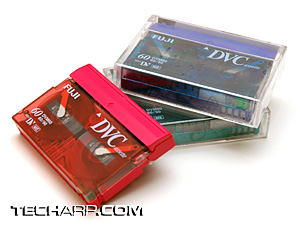Recording Media
DVD
Recording Mode |
Single Layer (1.3 GB) |
Dual Layer (2.6 GB) |
SD @ 9 Mbits/s |
19 mins |
28 mins |
SD @ 6 Mbits/s |
28 mins |
57 mins |
SD @ 3 Mbits/s |
57 mins |
1 hour 55 mins |
HD @ 15 Mbits/s |
11 mins |
23 mins |
HD @ 9 Mbits/s |
19 mins |
28 mins |
HD @ 5 Mbits/s |
34 mins |
1 hour 9 mins |
DVD camcorders make use of smaller 8 cm DVDs to store the video clips. These mini DVDs have a capacity of only 1.3GB (single-layer) and 2.6GB (dual-layer), which limits them to very short recording times. Even with a dual-layer DVD, it can be as short as just 23 minutes. This can be a problem if you need to record continuously for long periods of time, like during your child's drama play.
Even if you record only short clips, the short recording time requires you to swap DVDs quite often. This is not only inconvenient, it also requires you to carry a stack of DVDs for extended recording. The recording time can be extended but at the expense of video quality.
Although rewritable DVDs are available, currently they are only available in as single-layer discs which limits their capacity to only 1.3GB. Therefore, those who want to record reasonably long videos will have to buy dual-layer DVDs that can be only written to once. This generates a lot of waste as these DVDs cannot be reused.
While you may think of keeping these DVDs as archives, they aren't as indestructible as they seem. DVDs can suffer from DVD rot which renders them unreadable after just a few years. So, these mini DVDs aren't really suitable for anything more than medium-term storage.
Depending on the company, the camcorder will only support certain DVD formats. This limits your choice of DVDs. For example, Sony camcorders generally support only DVD-R, DVD±RW and DVD+R DL. They will not accept DVD+R or DVD-R DL discs.
Finally, DVDs are relatively expensive. They have a high cost per GB, compared to hard drives or MiniDV tapes. This is especially true for dual-layer DVDs. This high recording cost should be taken into account when you decide on your camcorder.
DVD camcorders are best for those who want to instantly deliver viewable DVDs without editing. Just pop in a DVD, record the clip, take out the DVD and play it on any DVD player or computer with a DVD drive.
MiniDV
Bit Rate |
Standard Definition |
High Definition |
25 Mbits/s (SP) |
1 hour |
1 hour |
18 Mbits/s (LP) |
1 hour 30 mins |
NA |
The MiniDV tape has been around for ages. Although it is not as long-lasting as a hard drive, it delivers an impressive 11.25GB storage capacity in a small, light form-factor. This gives you a full hour of recording per tape at the full 25Mbit/s bit rate, which can be extended to 90 minutes if recorded at the lower 18Mbits/s bit rate.
While this isn't as long as what a HDD camcorder is capable of, the quality of video recorded is much higher than that of HDD or DVD camcorders. This is due to the higher bit rate recorded, as well as the lower compression used. In addition, you can keep swapping tapes as they run out. If you are out in the field with no access to a notebook or desktop to offload your videos, a MiniDV camcorder can record far more video than a HDD camcorder since its actual recording time is only limited by the number of tapes and batteries you have.
However, MiniDV tapes do not allow random access. That means you cannot instantly select a particular file, much less a point in that file. Like analog tape recorders or players, you have to rewind or forward the tape to the point you want. In addition, when you want to transfer the recorded video to your PC, you have to do it in real-time. That means taking an hour to extract an hour of video from each tape. This is unlike HDD or DVD camcorders whose files can be extracted individually and at speeds limited only by the connection option used.
All MiniDV tapes are reusable. However, the tape do deteriorate with extended use. This does not mean that each reuse of the tape will reduce the video quality. Since the videos are recorded digitally, their quality remains the same until the tape loses enough material to affect the read head's ability to pick up the signals. This limits the number of times each tape can be reused.
Do note that because the tape is in contact with head and rollers, it leaves residue on all contact areas. If allowed to build up, it may cause tape feeding and recording problems. Hence, the need to regularly clean the camcorder with a cleaning tape. This is a maintenance step that HDD and DVD camcorders do not need to go through.
MiniDV camcorders are best for those who want the best video quality possible, as well as ease of editing (we will touch on this in the recording format section). MiniDV camcorders are also particularly suitable for those who want to record for long periods of time without offloading any video.







 Add to Reddit
Add to Reddit

